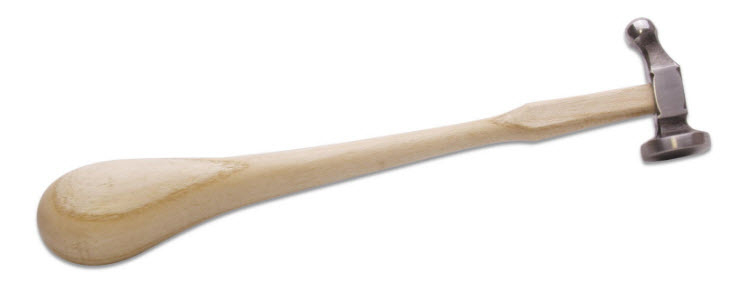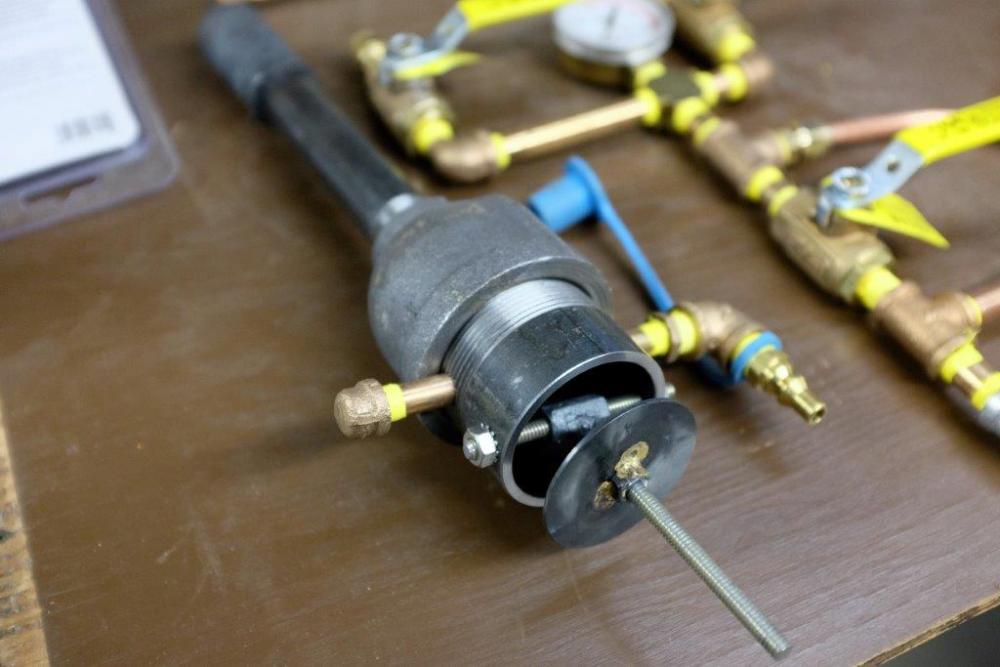-
Posts
88 -
Joined
-
Last visited
Content Type
Profiles
Forums
Articles
Gallery
Downloads
Events
Posts posted by WoodnMetalGuy
-
-
On 4/17/2017 at 1:55 AM, Mikey98118 said:
Originally hollow microspheres (AKA mcroballoons) were mixed into plastic to create composites known as syntactic foams;
I've used them in boatbuilding, mixed with epoxy to produce an easily sanded filler, not used for structural purposes. Hadn't thought about putting them in refractory... -- Dave
-
Thanks, Vaughn, I'm looking forward to trying this. I have some lead that I will probably use for two-sided stuff. And have some brass around, too. I'm thinking either of those would also work. -- Dave
-
1 hour ago, VaughnT said:
A lot of people use pitch bowls
Had not heard of these before, so I learned something new today. Here's a link to setting one up for anyone else who might not know what a pitch bowl is: http://www.alberic.net/Student_Home/Handout_Archive/files/PitchBowls V1-Web.pdf
Do I understand this correctly - that the idea with the copper that it's softer than the steel and so the ridges on the reverse side indent the copper vs. the copper mushing down the ridges?
-- Dave
18 hours ago, MrDarkNebulah said:If you do the whole printing and etching thing you need to make sure you use an inkjet printer and photo paper or else the transfer wont work well.
Another thing that works is using a laser printer - when you put the paper face down in contact with your work and heat the back of the paper with an iron, the toner will transfer to your work. I haven't ever tried that on metal, but it works on wood. Remember you need to print your design in reverse if you have lettering or other non-symmetric items.
-- Dave
-
7 minutes ago, Irondragon Forge & Clay said:
I did change the burner tube entry angle
OK, could not tell from the photo. It looked to me like it was still pointing directly into the middle vs. coming in at a tangent. Either way I'm not sure how much that matters. I think the key to heating is how much time the flame spends in the forge and how complete the burn is. Earlier today I ran across some interesting information in this document: http://azblacksmiths.org/wp-content/uploads/2016/04/Forge-build.pdf. Here's a quote from that:
QuoteThe blacksmithing lab provided another bit of information that seems counterintuitive. The lab has 12 forges whose housings are made from pipe. Some are 12”, some are 10” and others are 8” diameter. They all use 1” thick ceramic fiber blanket and all have the same the heat source: 2 burners, made from ¾” pipe with .o23 MIG tips for jets. And they are all plumbed into the same 500 gallon propane tank and each has a regulator set to around 12 psi. It would seem that the 8” forges would get hotter than the 12” forges. After all, there is less volume to heat and keep hot. We all know that the bigger the house, the larger sized heat pump is needed to heat or cool. In the lab however, observation tells us that the 12” forges get hotter than the 8” forges. Why? The answer was provided by one of my students who is an HVAC engineer. The flame needs room to complete its burn before it is interrupted (in this case, by the opposite side of the forge). Disrupting the burn means that some of the fuel is not burned, which not only means it doesn’t produce heat, but it actually cools off the flame in the same way that richening the mixture in a car engine makes it run cooler.
-- Dave
-
29 minutes ago, Latticino said:
Cheapest option I've seen work fairly effectively is a bucket of water suspended below the grinder platen where the bulk of the sparks go.
Yes, when I get my grinder built, I'm planning to just aim the sparks into a metal trash can or bin and contain most of the grit that way, as it doesn't float around in the air, like smoke or wood dust does. Maybe handling grinding particles that way and using a fume extractor for airborne smoke would be a good hybrid approach. -- Dave
-
I think Wayne was suggesting not that you rotate the forge body, but that you change the way the tube enters so that it's more tangental to the center space, rather than pointing across the middle of it.
However, in reading some material Ron Reil has on his website, he doesn't seem to totally agree with that philosophy, and even likes having a hot spot in there, so he can concentrate heat on his stock where he wants it...
-- Dave
-
Good story, thanks! I especially like the photo sequence from rough to finished, and your idea of making your own handle material. Did you use an epoxy resin for that, or something else? -- Dave
-
Redbate - As I understand it, if you coat with the rigidizer, you would still want to put on a layer of refractory (like satanite) to toughen up the interior and protect from dings from your work. However, I believe you can skip the rigidizer and just use satanite for both purposes (encapsulation and tough coating). That's where I am on my forge build and is the plan I'm going to follow. If someone thinks different, now would be a good time to chime in.
Regarding the fiber board on the interior, I don't think you need that. Just the kaowool lined with satanite. However, I will be using a piece of ceramic fiber board as a movable back wall in my tunnel-type forge to allow me to reduce the chamber volume for small work. And I expect that a smaller volume will be the general case.
I have a piece of kiln shelf for the floor, but I expect fire brick will work for you there.
-- Dave
-
Looks like it goes well. It will be fun to see it with some hot metal in there vs. the wooden board! -- Dave
-
Did you mean 1/2" square stock? So you want to make a 4 foot ring out of 1/2" square stock?
Probably in industry it would be done on a ring roller, two rolls on the bottom and an adjustable third one - a triangle configuration. Lowering the third roller gives a tighter radius.
And I have seen a similar configuration of round bars on a fly press to bend the stock bit by bit (generally cold) until the full circle is formed. Maybe you could do something similar to that with a couple blocks and a hammer and a template to judge whether you're on track or not?
-- Dave
-
3 minutes ago, Andres Bello said:
EDIT: Well, WMG jsut beat me to it by a few seconds.
Two great minds! I'm glad we came up with the same answer! -- Dave
-
I think you can just do a volume calculation and be pretty close.
You currently have 1 x .75 x 6.5 = 4.875 cubic inches. So your target is .5 x 1 x ? = 4.875, so your answer is 4.875 / .5 = 9.75 inches long.
Just doing this in your head you could see that the current cross section is .75 sq inches, and you're going for .5 sq inches, so based on the cross section being 2/3 as much, the length will be 3/2 or 1.5 as much.
-- Dave
-
Sorry, I'm not familiar with the internals of this vise, but since the handle seems to be unscrewing when you try to open the vice, part of the mechanism that secures the jaw to the screw must be broken or missing. If you start taking it apart it will probably become obvious at some point... -- Dave
-
Frosty - yes, good point. I was trying to explain the difference between compression and flare fittings, and am sorry if I confused the issue! -- Dave
-
18 minutes ago, ionicmuffin said:
With regards to the flare adapter you talk about in your instructions. Is this it? I guess I dont understand the terminology behind it:https://www.lowes.com/pd/BrassCraft-1-4-in-x-3-8-in-Compression-Compression-x-MIP-Adapter-Adapter-Fitting/50359448
No, that's a compression fitting. What you want to use to hook up to copper tube is a flare fitting of the appropriate size for the tube. Here's an example of a flare fitting: https://www.lowes.com/pd/BrassCraft-1-2-in-x-1-2-in-Threaded-Flare-x-MIP-Adapter-Adapter-Fitting/50380844
You need a flare nut to go with that. To make the connection, you slide the nut on the tube, then use a flaring tool to flare the end of the tube, then screw the nut onto the fiting, trapping the tube in between.
-- Dave
-
-
I like those hammer heads, and I think you could enhance the overall look of the tool by just doing a little additional shaping of the handles along the line of the photo below. I don't think it would take much to make them look a little more graceful. A spokeshave would be a great tool to use for that. -- Dave
-
19 hours ago, ForgeNub said:
Also having trouble developing a choke plate or something for the burner
Here's what I've got for a choke plate. I'll be trimming the threaded rod that the plate is on, don't need it so long. One weld to attach the threaded rod to the side of the coupling nut, and a braze to attach the nut to the choke plate, other than that it all threads together. -- Dave
-
32 minutes ago, Lapys said:
Do you happen to know of any resources or specific books I could take a look at to get a real novice's view of how these pieces fit together?
Here's what you want:
https://www.amazon.com/Wiring-Simplified-Based-National-Electrical/dp/097929455X
You may be able to find this at a Menards or Home Depot, also. Good book that shows you exactly how to hook up your plug and switch, etc. Geared to beginners.
If you need to restrict airflow you could partially block the input of your blower. Some little bit of sheet metal on a screw that you can pivot over the intake. The fan in your photo looks like a little squirrel cage fan, which won't be able to build much pressure. If you need more air you may want to look for a radial vane fan like the traditional hand-cranked coal forge blowers. Or like what is used in shop vacs.
Here's an example of a radial vane fan. Not that you'd want to use this one in particular, but you can see how the fan vanes are differently arranged: http://www.surpluscenter.com/Electrical/Blowers-Fans/DC-Centrifugal-Blowers/12-VDC-DRAFT-INDUCTION-BLOWER-16-1390.axd
-- Dave
-
If that's a 12V motor, you won't be able to plug it into the wall, which is 120V.
And if you meant 120V, you still won't be able to plug into household power if it's three-phase.
Sorry, I don't know how you'd run one of those...
-- Dave
-
Nice, thanks for that explanation. I can see the hinge now. And I really like the cast brass knobs - I hadn't picked up on that detail before! -- Dave
-
John - Looks nice - I've been contemplating building one lately. Where did you source the wheels? And is there a tracking adjustment somewhere? I couldn't spot it in the photos. Thanks - Dave
-
On 2/27/2017 at 7:38 PM, Pancho07 said:
This ended up being too tall to fit under our cabinets but I'm happy with it otherwise
And I bet it wouldn't be too bad to rework the bottom to shorten it up by a few inches? -- Dave
-
That should hold it!
But seriously, I can't help with the real question on the hot chrome - hopefully someone will chime in on that... -- Dave





Belt Grinders
in Grinders, Sanders, etc
Posted
Sounds like that's talking about adjusting the belt tracking... -- Dave